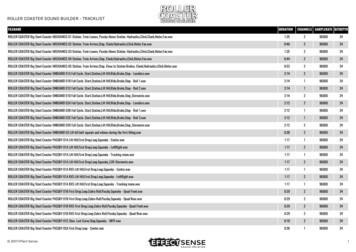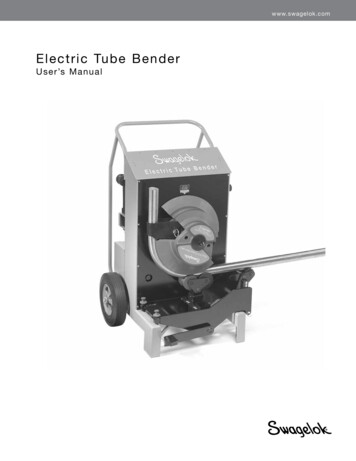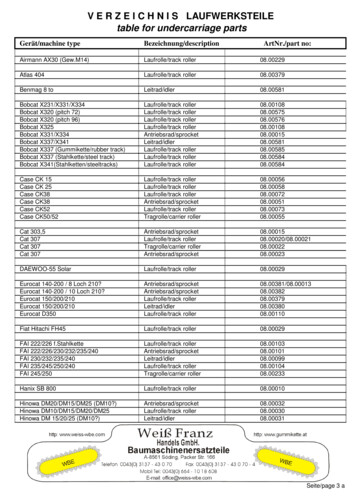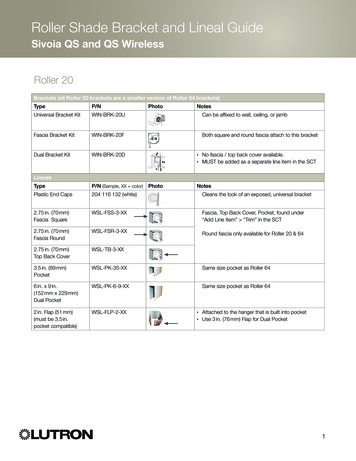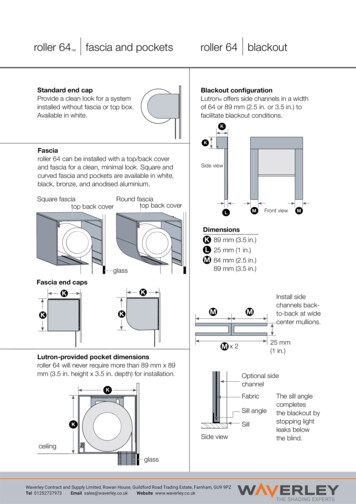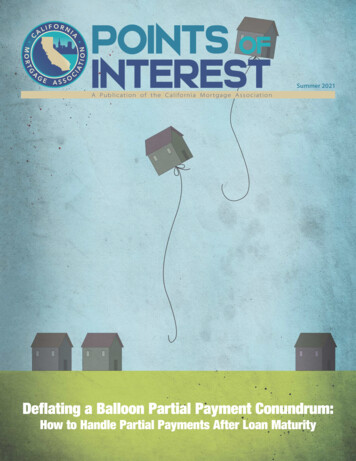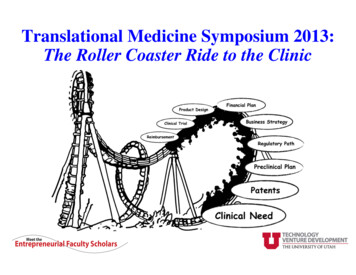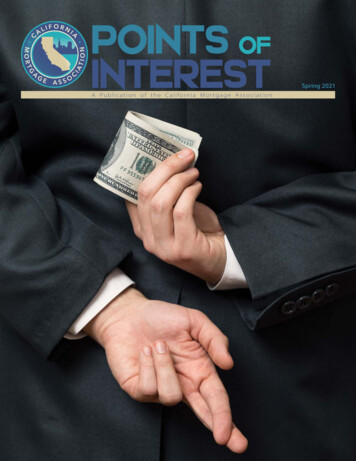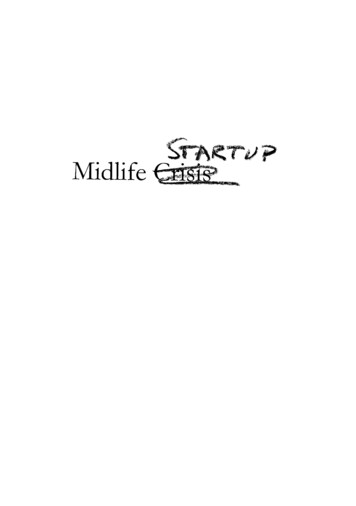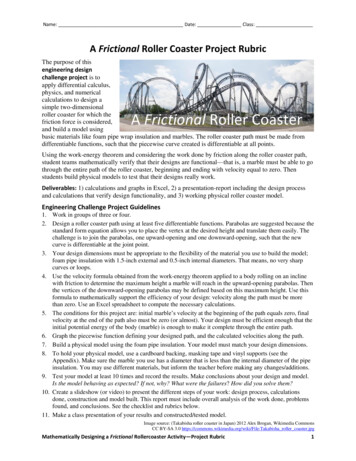
Transcription
Name: Date: Class:A Frictional Roller Coaster Project RubricThe purpose of thisengineering designchallenge project is toapply differential calculus,physics, and numericalcalculations to design asimple two-dimensionalroller coaster for which thefriction force is considered,and build a model usingbasic materials like foam pipe wrap insulation and marbles. The roller coaster path must be made fromdifferentiable functions, such that the piecewise curve created is differentiable at all points.A Frictional Roller CoasterUsing the work-energy theorem and considering the work done by friction along the roller coaster path,student teams mathematically verify that their designs are functional—that is, a marble must be able to gothrough the entire path of the roller coaster, beginning and ending with velocity equal to zero. Thenstudents build physical models to test that their designs really work.Deliverables: 1) calculations and graphs in Excel, 2) a presentation-report including the design processand calculations that verify design functionality, and 3) working physical roller coaster model.Engineering Challenge Project Guidelines1. Work in groups of three or four.2. Design a roller coaster path using at least five differentiable functions. Parabolas are suggested because thestandard form equation allows you to place the vertex at the desired height and translate them easily. Thechallenge is to join the parabolas, one upward-opening and one downward-opening, such that the newcurve is differentiable at the joint point.3. Your design dimensions must be appropriate to the flexibility of the material you use to build the model;foam pipe insulation with 1.5-inch external and 0.5-inch internal diameters. That means, no very sharpcurves or loops.4. Use the velocity formula obtained from the work-energy theorem applied to a body rolling on an inclinewith friction to determine the maximum height a marble will reach in the upward-opening parabolas. Thenthe vertices of the downward-opening parabolas may be defined based on this maximum height. Use thisformula to mathematically support the efficiency of your design: velocity along the path must be morethan zero. Use an Excel spreadsheet to compute the necessary calculations.5. The conditions for this project are: initial marble’s velocity at the beginning of the path equals zero, finalvelocity at the end of the path also must be zero (or almost). Your design must be efficient enough that theinitial potential energy of the body (marble) is enough to make it complete through the entire path.6. Graph the piecewise function defining your designed path, and the calculated velocities along the path.7. Build a physical model using the foam pipe insulation. Your model must match your design dimensions.8. To hold your physical model, use a cardboard backing, masking tape and vinyl supports (see theAppendix). Make sure the marble you use has a diameter that is less than the internal diameter of the pipeinsulation. You may use different materials, but inform the teacher before making any changes/additions.9. Test your model at least 10 times and record the results. Make conclusions about your design and model.Is the model behaving as expected? If not, why? What were the failures? How did you solve them?10. Create a slideshow (or video) to present the different steps of your work: design process, calculationsdone, construction and model built. This report must include overall analysis of the work done, problemsfound, and conclusions. See the checklist and rubrics below.11. Make a class presentation of your results and constructed/tested model.Image source: (Takabisha roller coaster in Japan) 2012 Alex Brogan, Wikimedia CommonsCC BY-SA 3.0 https://commons.wikimedia.org/wiki/File:Takabisha roller coaster.jpgMathematically Designing a Frictional Rollercoaster Activity—Project Rubric1
Name: Date: Class:ChecklistFinal Project Results Presentation-Report1. Slide with project title and student names2. Slide with project description and purpose, and a summary of theresults obtained3. Slide(s) that describe the curves used to create piecewise roller coasterpath, and method used to obtain a continuous and differentiable path.4. Slide(s) with the graph and final explanation of the piecewise rollercoaster path.5. Slide(s) that describe how the work-energy theorem was used to verifydesign functionality and to find the velocity of the body along the rollercoaster path.6. Slide(s) with the graphs of the velocity of the body, coefficient offriction, and friction force versus horizontal displacement; graphs mustbe labeled, and x-y-axes units specified.7. Slide(s) that describe the construction process, materials used, finaldimensions, accuracy with respect to mathematical design, and photosof the constructed roller coaster model.8. Slide(s) that explain the prototype tests performed and resultsobtained.9. Slide(s) with final conclusions about how similar the expected resultswere from the mathematical design, and the final prototype results.10. Slide(s) with professionally presented bibliography-references used.Total PointsIn-Class Results Presentation Checklist11. Slideshow or video (mp3, wma, mpeg) containing information andresults listed in items 1-10 (above) with recorded explanations. A fullreport delivered as a standalone slideshow or video with recordedexplanations earns 40 extra points.12. In-class results presentation with proficient presentation and answers.13. Students look professional (as if for a professional job interview).Total PointsMax Points Evaluation552052051510105100Max Points Evaluation20or603010100Notes: No projects accepted after the due date: In-class project-presentation is mandatory. During tutorial time, help will be available for thephysics concepts, Excel calculations and graphs,physical model construction, and presentation. Due date: [ date here ]Image source: (Anaconda roller coaster in VA) 2007 Checho16, Wikimedia CommonsCC BY-SA 3.0 https://commons.wikimedia.org/wiki/File:Anaconda roller Coaster.jpgMathematically Designing a Frictional Rollercoaster Activity—Project Rubric2
Name: Date: Class:Additional ResourcesCalculusLarson, Ron, Edwards, Bruce, and Hostetler, Robert P. Calculus of a Single Variable. Eighth Edition.Boston, MA: Houghton-Mifflin, 2006.Briggs, William L., Cochran, Lyle, and Gillett, Bernard. Calculus AP Edition. Upper Saddle River, NJ:Pearson Education, 2014.PhysicsYoung, Hugh D., & Freedman, Roger. University Physics with Modern Physics.14th Edition, Pearson,2016.Harris, Benson. University Physics. Second Edition, John Wiley & Sons, Inc., 1995.Alonso, Marcelo, & Edward, Finn. Fundamental University Physics, Volume 1 Mechanics. AddisonWesley, 1966 (Spanish version: Fisica Volumen 1, Mecanica. Fondo Educativo Interamericano, 1976).Halliday, David, & Resnick, Robert. Physics, Parts 1 and 2 Combined. Second Edition. John Wiley &Sons, Inc., 1966 (Spanish version: Fisica, Edicion Combinada Partes I y II, CECSA, Tercera Edicion,1976).General MathematicsDemana, Franklin, et al. Precalculus, Graphical, Numerical, Algebraic. Second Edition. Pearson, 2016.Pownal, Malcom. Functions and Graphs, Calculus Preparatory Mathematics, Prentice-Hall, 1983.Excel and PowerPointExcel: Get Started with Formulas and Functions. Microsoft Office 0c4961-a7b2-a0fc5866735eTips for Making Effective PowerPoint Presentations. May 28, 2009. National Conference of StateLegislatures. xMicrosoft PowerPoint Tutorials. Electric Teacher. t SupportAP Calculus First Semester Project online tutorial for students at s-first-semester-project, on the following topics: Friction concepts and solutions for the problem of a body rolling on a surface with friction Rotational kinematics and dynamics Piecewise differentiable functionsRoller CoastersBrooks, Meade. Physics Concepts in Action Physics Roller Coaster. 2014. Collin College, Frisco, ller Coaster Physics. Real-World Physics Problems.com. oaster-physics.htmlHow Do Roller Coasters Work? Wonder of the Day #1239. Physical Science, Science, Wonderopolis.org.National Center for Families Learning. ers-workSastamoinen, Shawna. Roller Coaster Physics: The Science Behind the Thrills. 2002. Physics 211X,University of Alaska Fairbanks. http://ffden2.phys.uaf.edu/211 fall2002.web.dir/shawna sastamoinen/Roller Coasters.htmMathematically Designing a Frictional Rollercoaster Activity—Project Rubric3
Name: Date: Class:Final Project Results Presentation-Report Grading RubricBelow StandardMeets StandardAbove StandardProject Title,Student Names- Incomplete or missing project name, studentnames, and/or date- Project name, student names, and datedisplayed- Professional text/graphics on title slide- Project name, student names, date displayed- Pleasing graphic and or animation- Background musicProjectDescription- Missing or incomplete outline of the projectobjective- Missing or incomplete outline of theprocedures and resources used- Missing or incomplete outline of obtainedresults- Correct description of project objective- Correct outline of the procedures andresources used- Correct summary of obtained results- Correct description of project objective- Correct outline of the procedures andresources used- Correct summary of obtained results- Figures/images that help understanding- Eye-catching slide format and/or animationsRoller CoasterPath Design- Incomplete or missing description of thedifferentiable functions used to create thepiecewise path- Fewer than 5 differentiable functions used tocreate the piecewise path- Incomplete or missing process used to createthe pricewise path from the differentialfunctions- Incomplete or missing final functionalexpression for the piecewise path- Incomplete or missing roller coaster pathgraph- Text incorrectly formatted, labeled orseparated- Text difficult to read (font size 24, colornot enough contrast with slide background)- Complete description of the differentiablefunctions used to create the piecewisepath- At least five differentiable functions usedto create the piecewise path- Complete process used to create thepricewise path from the differentialfunctions- Complete final functional expression forthe piecewise path- Complete and well-formatted rollercoaster path graph- Text formatted, clearly labeled andseparated- Text easy to read (font size 24, colorgood contrast with background color- Complete description of the differentiablefunctions used to create the piecewise path- At least five differentiable functions used tocreate the piecewise path- Complete process used to create the pricewisepath from the differential functions- Complete final functional expression for thepiecewise path- Complete and well-formatted roller coasterpath graph- Text formatted, clearly labeled and separated- Text easy to read (font size 24, font colorgood contrast with background color)- Eye-catching slide format and animations- Incomplete or missing description of theanalysis of the roller coaster pathfunctionality using the work-energy theorem- Incorrect or missing mathematicalexpression used in the project for the workenergy theorem- Incomplete or missing graphs of the velocityof the body, friction coefficient, and frictionforce along the piecewise path- Complete description of the analysis ofthe roller coaster path functionality usingthe work-energy theorem- Correct mathematical expression used inthe project for the work-energy theorem- Axes correctly formatted and labeled- Complete graph set of the velocity of thebody, friction coefficient, and frictionforce along the piecewise path- Graph titles included and easy to read- Graph colors with good contrast- Complete description of the analysis of theroller coaster path functionality using thework-energy theorem- Correct mathematical expression used in theproject for the work-energy theorem- Axes correctly formatted and labeled- Complete graph set of the velocity of thebody, friction coefficient, and friction forcealong the piecewise path- Graph titles included and easy to read- Graph colors with good contrast- Eye-catching slide format and animations.MathematicalDesign TestedUsing the WorkEnergy TheoremA Frictional Rollercoaster Activity—Project Rubric4
Name: Date: Class:Below StandardMeets StandardPrototype’sConstruction Processand Final Prototype- Incomplete or missing constructionprocess description- Incomplete or missing materials listfor building the physical prototype- No photo of the final prototype- Missing/incorrect prototype scalefactor- Missing/incomplete analysis of theaccuracy of the mathematical modeland prototype- Text difficult to read (font size 24,font color not enough contrast withslide background)Prototype Tests- Missing or incomplete prototype tests- Fewer than 10 tests run- Incomplete/missing testing resultsobtained- Incomplete/missing test conclusions- Incomplete/missing analysis ofobserved deviations in the prototypebehavior and the expected behavior- Text difficult to read- Text colors difficult to seeRoller CoasterPrototype Construction- Unfinished roller coaster prototype,not fully functional and/or missing- Prototype shape does not matchoriginal design- Prototype built at incorrect scale-Project Conclusions, andBibliography-References- Missing, incomplete or incorrectconclusions- Conclusions missing or poorly donein problem context- Missing/incomplete references andsource materials list; poorly presented- Correct conclusions, procedures andresults- Conclusions completed in problem context- Complete references/source materials thatare professionally presentedA Frictional Rollercoaster Activity—Project Rubric- Complete construction process description- Complete materials list for building thephysical prototype- Photo of the final prototype- Correct prototype scale factor provided- Analysis of the accuracy of themathematical model and prototype- Text easy to read (font size 24, font colorcontrasts with background color)-Complete prototype testsAt least 10 tests runComplete testing results obtainedTests conclusions providedAnalysis of observed deviations in theprototype behavior and expected behavior- Text easy to read (font size 24, font colorcontrasts with background color)Finished and fully functional prototypePrototype shape matches original designPrototype built to correct scaleNeat and tidy prototype finishingAbove Standard- Complete construction process description- Complete materials list for building thephysical prototype- Several photos show the final prototype andthe construction process- Correct prototype scale factor provided- Analysis of the accuracy of the mathematicalmodel and prototype- Text formatted, clearly labeled and separated- Text displayed easy to read (font size 24,font color contrasts with background color)- Eye-catching slide format and animations-Complete prototype tests10 or more tests runComplete testing results obtainedTests conclusions providedAnalysis of observed deviations in theprototype behavior and expected behavior- Text formatted, clearly labeled and separated- Text displayed easy to read (font size 24,font color contrasts with background color)- Eye-catching slide format and animations.-Finished and fully functional prototypePrototype shape matches original designPrototype built to correct scaleNeat and tidy prototype finishingArtistic touches in prototype finishing- Correct conclusions, procedures and results- Conclusions completed in problem context- Complete references/source materials that areprofessionally presented- Eye-catching slide formats, animations andfigures that aid in audience understanding5
Name: Date: Class:In-Class Results Presentation Grading RubricUnprofessionalNearly Professional- Sight not on the audience- Reads from notes or slides- Lacks confidence during theentire presentation- Distracting, unnaturalmovements or gestures(fidgeting or nervous)- Some audience eye contact- Sometimes reads from notesor slides- Some confidence and poise(but still appears nervous)- Some movement and gestures- Eye contact with audience- Little or no reading fromslides or notes- Looks confident during theentire presentation- Natural movements, gestures- Speaks too softly to beunderstood and/or heard- Speaks too quickly or slowly- Frequently uses words orsounds like: Okay, so , youknow , uh, umm, I mean - Does not use correct technicallanguage or formal English- Speaks clearly most of thetime- Sometimes speaks tooquickly or slowly- Speaks loudly enough formost of the audience- Occasionally uses words orsounds like: Okay, so , youknow , uh, umm, I mean - Uses correct technicallanguage or formal Englishmost of the presentation- Speaks clearly during theentire presentation- Speaks at uniform volume,and at a normal pace, not tooquickly or slowly- Speaks loudly enough foreveryone to hear- Rarely or never uses words orsounds like: Okay, so , youknow , uh, umm, I mean - Uses correct technicallanguage or formal Englishduring the entire presentationOverallPresentation- No main idea present, wrong,or incomplete- Ideas presented in a wrongand/or illogical sequence- Missing important steps in thedevelopment- Missing, incorrect orincomplete introductionand/or conclusion,- Poor presentation timemanagement- Incorrect answers to questions- Main idea present, but notproficiently explained- Ideas presented in a logicalorder but not proficientlyconnected or missingimportant points- Introduction and conclusion,present but are not effective- Presentation completed in theallotted time, but time notproficiently distributed overtopics or ideas- Correctly answered mostquestions, and in context- Main idea presented in a clearand effective way- Ideas presented in a logicalorder, emphasizing mainpoints, and in context- Effective introduction andconclusion- Presentation completed in theallotted time, and timeproficiently distributed overtopics or ideas- Correctly answered questions,and in context; also enrichedanswers with relevant infoand/or pertinent examplesStudents Look- Wearing inappropriate clothesfor the occasion- Wearing semi-formal clothes- Wearing appropriate clothesfor the occasion, as if for aprofessional job interviewBody LanguageVoiceA Frictional Rollercoaster Activity—Project RubricProfessional6
Name: Date: Class:Appendix: Suggested Materials for Physical Roller Coaster ModelFor this project, it is recommended that you build the rollercoaster model using inexpensive materials thatare easy to work with. Other materials than those suggested below may be used, but notify the teacher inadvance. The following materials can be found in hardware and craft supply stores such as Home Depot,Lowes, Office Depot, Hobby Lobby or Michaels.Suggested fabrication materials: foam pipe wrap insulation, Tubolit ½-in x 6-ft vinyl bullnose archway corner bead, ¾-in x 10-ft corrugated cardboard or plastic sheets, 3 x 4-ft size 1-inch masking tape glass marblesAdditional tools and resources: yardstick or 1-m ruler with inch-scale markings scissors, utility knife, super glue (optional) pegboard, 2 x 4-ft, to use as a mat toeasily draw points on cardboard sheetA Frictional Rollercoaster Activity—Project RubricParabolic Roller Coaster60504030201000102030405060708090-107100
expression used in the project for the work-energy theorem - Incomplete or missing graphs of the velocity of the body, friction coefficient, and friction force along the piecewise path - Complete description of the analysis of the roller coaster path functionality using the work-energy theorem - Correct mathematical expression used in
